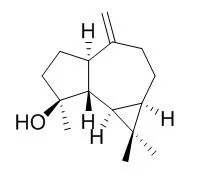| In vitro: |
| Phytother Res. 2011 Apr;25(4):557-62. | | Identification of spathulenol in Salvia mirzayanii and the immunomodulatory effects.[Pubmed: 20857430] | The methanol extract of Salvia mirzayanii has shown an immunomodulatory effect on peripheral blood lymphocytes.
METHODS AND RESULTS:
Bioassay-guided fractionation using a lymphocyte proliferation assay on Salvia mirzayanii was performed in order to purify and identify the active compounds. Fractionation of the methanol extract and purification of the components using normal column chromatography and preparative thin layer chromatography resulted in identification of the bioactive compound, Spathulenol, with an immunoinhibitory effect. Identification of this compound was performed by 1D and 2D NMR methods and HRMS. Treatment of activated lymphocytes with a concentrated fraction containing 62% of Spathulenol (SP) showed a decrease in the proliferation of lymphocytes with an IC(50) of 85.4 ± 11.08 µg/mL. Flow cytometry analysis using annexin V and propidium iodide staining of the stimulated peripheral blood lymphocytes in the presence of Spathulenol demonstrated a dose dependent increase in the percentage of apoptotic cells (IC(50) ; 77.2 ± 5.31 µg/mL). No significant increase in caspase 3 activity in a 20 h treatment of stimulated lymphocytes compared with the control was observed.
CONCLUSIONS:
In conclusion, this study identified the possible activity of Spathulenol as one of the immunomodulatory compounds present in Salvia mirzayanii. Spathulenol showed the capacity to inhibit proliferation in the lymphocytes and to induce apoptosis in these cells possibly through a caspase-3 independent pathway. | | J Ethnopharmacol . 2018 Jan 10;210:351-358. | | Antioxidant, anti-inflammatory, antiproliferative and antimycobacterial activities of the essential oil of Psidium guineense Sw. and spathulenol[Pubmed: 28844678] | | Abstract
Ethnopharmacological relevance: Leaves from Psidium guineense Sw. are used in popular medicine for the treatment of inflammatory disease. However, there is no scientific evidence demonstrating this activity.
Aim of the study: To evaluate the antioxidant, anti-inflammatory, antiproliferative and antimycobacterial activities of the essential oil of P. guineense and Spathulenol (a major constituent). The study was conducted in part to provide evidence supporting the ethnobotanical use of the leaves of this species.
Material and methods: The essential oil (EOPG) was extracted from the leaves of P. guineense by hydrodistillation and analysed by gas chromatography-mass spectrometry (GC-MS). The major compound, Spathulenol (PG-1), was isolated in a chromatographic column and characterized by nuclear magnetic resonance (NMR). EOPG and PG-1 were evaluated in vitro for antioxidant activity by DPPH, ABTS and MDA methods; anti-inflammatory potential was assessed using two models, including pleurisy and oedema, in mice. The impact of EOPG and PG-1 on cell proliferation was determined via spectrophotometric quantification of the cellular protein content using a sulforhodamine B assay, and anti-Mycobacterium tuberculosis activity was determined using the REMA method.
Results: A total of 38 components were identified from the EOPG, with the sesquiterpenic alcohol Spathulenol (PG-1) (80.7%) being the major constituent. EOPG and PG-1 exhibited the highest antioxidant activities in the DPPH and MDA system compared with reference standard, with IC50 values ranging from 26.13 to 85.60μg/mL. Oral administration of EOPG and PG-1 showed significant inhibition in the Cg-induced mice paw oedema and pleurisy model. The EOPG (GI50 = 0.89μg/mL) and PG-1 (GI50 = 49.30μg/mL) were particularly effective against the ovarian cancer cell line. Both showed moderate antimycobacterial activity.
Conclusion: For the first time, this study demonstrated the antioxidant, anti-inflammatory, antiproliferative and antimycobacterial properties of the essential oil of P. guineense (leaves were collected in Dourados-MS) and Spathulenol, collaborating the etnhopharmacologycal use of this plant due to its an anti-inflammatory effect.
Keywords: (1)H NMRProton nuclear magnetic resonance of hydrogen; (13)C NMRCarbon-13 nuclear magnetic resonance; 786-0Renal; AA%Antioxidant activity; ABTS2,2′-Azino-bis(3-ethylbenzthiazoline-6-sulfonic acid); Anti-Mycobacterium tuberculosis; Antioxidant; Antiproliferative; Araçá; BHTButylated hydroxytoluene; CCColumn chromatography; CDCl(3)Deuterated chloroform; CO(2)Carbon dioxide; Cgλ–carrageenan; DEXADexamethasone; DMSODimethylsulfoxide; DOXDoxorubicin; DPPH2,2-Diphenyl-1-picrylhydrazyl; EOPG-1Essential oil of P. guineense-sub-fraction 1; EOPG-4Essential oil of P. guineense-sub-fraction 4; EOPG-7Essential oil of P. guineense-sub-fraction 7; EOPGEssential oil of Psidium guineense; GC-MSGas chromatograph - mass spectrometry; GI(50)Growth inhibitory for 50% of cell; HT-29Colon cell line; HaCaTKeratinocytes; I%Inhibition percentage; IC(50)Concentration resulting in 50% inhibition; IL-1βInterleukin-1 beta; IL-6Interleukin-6; IL-8Interleukin-8; IPPIsopentenyl pyrophosphate; K-562Leukaemia; LC(50)Concentration killing 50% of cells; MCF-7Breast; MDAMalondialdehyde; MHzMegahertz; MICConcentration inhibition minimum; MM-1Matriz metalloproteinase-1; MTBMycobacterium tuberculosis; NCI-ADR/RESOvarian expressing the phenotype of multiple drug resistance; NCI-H460Lung; NCINational cancer institute; NONitric oxide; OVCAR-3Ovarian; Oedema; PBSPhosphate buffered saline; PCO-3Prostate; PG-1Compound Spathulenol; Pleurisy; REMAResazurin microtiter assay; RPMI-1640Roswell park memorial institute 1640 medium; TGIGrowth inhibitory for 50% of cell; TLCThin-layer chromatography; TMSTetramethylsilane; TNF-αTumour necrosis factors-alpha; U251Glioma. |
|






 Cell. 2018 Jan 11;172(1-2):249-261.e12. doi: 10.1016/j.cell.2017.12.019.IF=36.216(2019)
Cell. 2018 Jan 11;172(1-2):249-261.e12. doi: 10.1016/j.cell.2017.12.019.IF=36.216(2019) Cell Metab. 2020 Mar 3;31(3):534-548.e5. doi: 10.1016/j.cmet.2020.01.002.IF=22.415(2019)
Cell Metab. 2020 Mar 3;31(3):534-548.e5. doi: 10.1016/j.cmet.2020.01.002.IF=22.415(2019) Mol Cell. 2017 Nov 16;68(4):673-685.e6. doi: 10.1016/j.molcel.2017.10.022.IF=14.548(2019)
Mol Cell. 2017 Nov 16;68(4):673-685.e6. doi: 10.1016/j.molcel.2017.10.022.IF=14.548(2019)